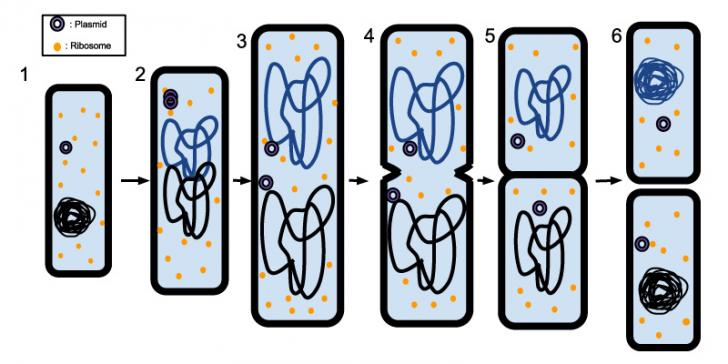Evolved nearly 4 billion years ago, prokaryotic cell is the simplest form of cells which lack defined nucleus or membrane-bound nucleus as well as other membrane-bound cell organelles.
Types of Prokaryotes
Organisms which are made up of prokaryotic cells are known as prokaryotes. Based on the genetic recipe and composition of the cell wall, these single-celled organisms are broadly divided into two domains – archaea and bacteria.
Archaea believed to be the linking bridge between bacteria and eukaryote, archaea is one of the most primitive forms of lives.
Bacteria are other earliest forms of lives which are slightly developed than the archaea. 
Structure
Visible only through light microscope or electronic microscope, prokaryotic cell is as small as mitochondria. Usually, it has diameter ranging from 0.1 to 5.0 µm. However, there is a prokaryote called Thiomargarita namibiensis which is 750 µm big.
Although prokaryotic cell is one of the most primitive forms of lives, it is present with prokaryotic cytoskeleton (complex network of interlinking tubules and filaments that extend throughout the cytoplasm). Flagellum is a significant cytoskeletal protein which helps locomotion and chemotaxis. The cell may also contain pili and fimbriae. The pili help in exchange of genetic material while fimbriae help in attaching to the host cell.
A peculiar feature of this cell is that it lacks membrane-bound nucleus and cell organelles such as mitochondria, golgi bodies, lysosomes, etc. It, instead, has a region termed as nucleoid which consists of circular, chromosomal, single or more loops of DNA. Along with the DNA, ribosomes are present where protein synthesis occurs. Some prokaryotic cell also has membranous organelle such as vacuole which is responsible for metabolic activities such as photosynthesis.
DNA and ribosomes are present in a jelly-like cytosol called cytoplasm. It is made up of nearly 80% water along with substances like water soluble protein, carbohydrate, lipids, inorganic salts, etc.
All these components of the cell are held together by the help of plasma membrane. It is semi-permeable in nature which prevents diffusion of protein and ions into the external environment, allowing only waste products to pass through it. It is a thin layer of lipid (usually 6 -8 nm) surrounding the entire cell. Generally, plasma membrane is bilayer of phospholipid but some archaean have monolayer.
Plasma membrane is further protected from the external environment by the cell wall. Varying from archaea to bacteria, the cell wall might be composed of isoprene or peptidoglycan. Besides, it is highly concentrated with dissolved solutes which prevent osmotic lysis. Cell wall also helps in maintaining shape and prevents dehydration.
Reproduction
Prokaryotes reproduce asexually. In this form of reproduction, a single organism is responsible for the production of offspring. This process completely excludes fusion of gametes. Thus, offspring inherit identical genes of only one parent. As a result, chance of mutation is negligible.
Among various types of asexual reproduction, binary fission is the process that prokaryotes multiply. It is the process of division of a cell into two identical parts which develop into independent bodies.
Steps Involved in Binary Fission of Prokaryotes

- The DNA of the cell starts to uncoil and replicate within the cell.
- The replicated DNAs split while plasmid replicate.
- The DNA along with plasmid starts to move towards the opposite pole.
- The cell wall begins to develop, creating constriction around the middle of the cell.
- The constriction grows deeper while the new cell is developing.
- The fully developed cell finally separate, forming independent daughter cells.
Usually, binary fission is a rapid process which takes only around 20 minutes to complete. However, not all cells undergo replication every 20 minutes. It takes a new cell as long as 24 hours to prepare itself for replication.
DNA Transfer
Although, prokaryotes are known to reproduce asexually through binary fission, there still occurs transfer of genetic material in the form of horizontal gene transfer. Transformation, transduction and conjugation are some methods of horizontal gene transfer. However, DNA transfer is majorly noted in bacteria than in archaea.
Transduction
Transduction is the process of transferring of DNA from one bacterium to the other by the help of a virus (bacteriophage). It does not require physical contact of the DNA donor and the DNA donee.
Transformation
Transformation is the process of transferring of DNA from one bacterium to the other by the help of plasmid. It also does not require physical contact of the DNA donor and the DNA donee.
Conjugation
Conjugation is the natural process of transferring of genetic material directly by cell-to-cell contact. It can also be conducted through a bridge like linkage between the cells.
Points to remember
- It lacks a defined nucleus and other membrane-bound organelles such as mitochondria, endoplasmic reticulum, golgi bodies, etc.
- The DNA is located at the central region called nucleoid.
- Ribosome and plastids are present.
- It has prokaryotic cytoskeleton.
- Its outermost layer is cell wall which protects, prevents dehydration and maintains the cell shape.
- Composition of cell membrane varies significantly in archaea, bacteria and among the types of bacteria.
- The plasma membrane is semi-permeable in nature.
- It reproduces asexually by various processes like binary fission.
- Exchange of genetic material occurs through transformation, transduction and conjugation.